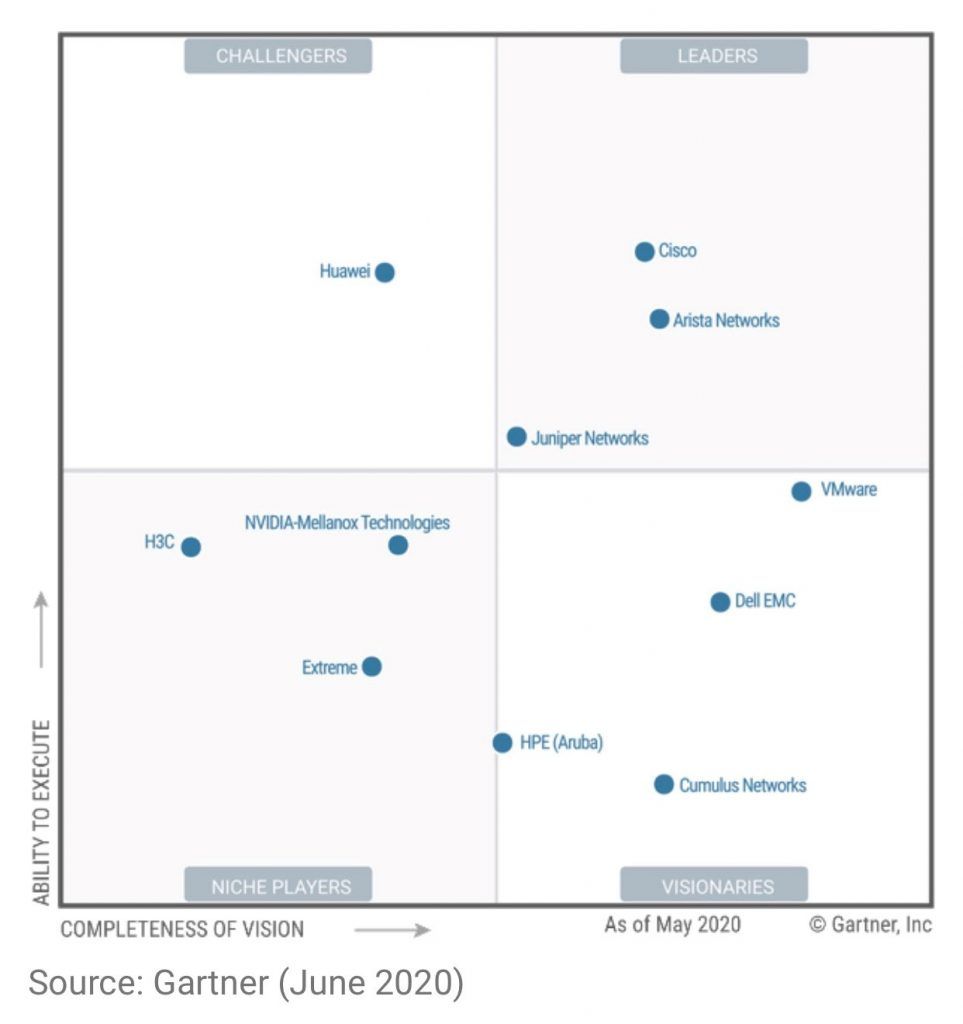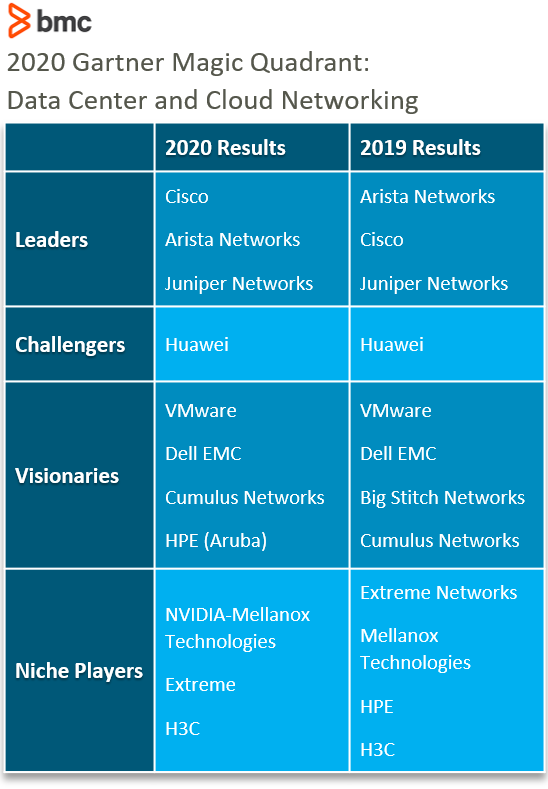No matter their industry, enterprises from around the world eagerly anticipate the unveiling of Gartner Magic Quadrants. This series of market research reports offers unrivaled insights for key decision makers when comparing vendors for specific services. It’s also useful for the organizations themselves, seeing how they land in their field of competitors.
The Magic Quadrant for Data Center and Cloud Networking is no different.
Due to the demand and high usage of cloud computing and cloud-based services, this Magic Quadrant has been renamed from “Magic Quadrant for Data Center Networking” to “Magic Quadrant for Data Center and Cloud Networking”. This shift in title reflects the changing expectations of the modern enterprise along with the virtualization and automation that is typically being utilized inside data centers.
As in previous years, the 2020 Magic Quadrant provides some interesting information, offering talking points for clients and leaders alike. Here are the results of Gartner’s 2020 Magic Quadrant for Data Center and Cloud Networking.
Defining “Data Center and Cloud Networking”
Gartner defines data center and cloud networking vendors as full stack infrastructure suppliers who provide software or hardware that addresses existing and emerging enterprise data center and cloud networking requirements.
Vendors need to offer at least three components that comprise eligible solutions:
- Virtual switches
- Physical switches
- Network overlays
- Network operating systems
- Programmable fabric
Magic Quadrant for Data Center and Cloud Networking 2020
The Magic Quadrant for Data Center and Cloud Networking is represented here:

Published by Gartner, Inc., this graphic should be evaluated in the context of the entire research document.
Results at-a-glance
In order to fully utilize the results of the Data Center and Cloud Networking Magic Quadrant, it’s important to understand the criteria for each category.
- Leaders. Typically, innovative giants who excel at both vision and execution.
- Challengers. Strong execution but low vision.
- Visionaries. Good vision but low execution.
- Niche Players. Hyper-focused on a small segment, resulting in low vision and low execution.
The below chart compares the 2019 Magic Quadrant to this year’s results:

Strong Leaders in Data Center and Cloud Networking
Although the three vendors remained consistent in the Leaders Quadrant from 2019 to 2020, their positions within this quadrant shifted slightly.
Cisco
Jumping up to the front in the Leader’s Quadrant this year is Cisco, worldwide leader in IT, networking, and cybersecurity solutions. Cisco has a large, well-established global customer base along with solid products that feature advanced technologies. Its offerings include:
- Nexus switches
- Fabric management
- Network insights tools
Its roadmap forecasts increasing levels of automation and analytics for clients, aligning with the need for a more self-healing and autonomous network.
Arista Networks
Continuing in the Leader Quadrant in 2020 is computer networking giant Arista Networks. Specializing in building ultra-low-latency and scalable networks, the organization continues to grow, thanks to its recent acquisition of Big Switch Networks, an SDN and network monitoring pioneer. Arista’s largest offering is Universal Cloud Network (UCN), which includes an Extensible Operating System (EOS), 7000 series switches, and its CloudVision visibility and management platform.
With deep expertise and strong support capabilities, it can be assumed that Arista will continue to remain a Leader in the industry for years to come.
Juniper Networks
Rounding out the Leader quadrant in this year’s research results is data networking corporation Juniper Networks. Its main offerings include:
- The Contrail Enterprise Multicloud
- Junos OS
- The QFX5000 and QFX10000 series switches
Juniper Networks also develops products such as network management software, routers, switches, and network security technology. Juniper has solid software and hardware, providing capabilities to meet the technical needs of nearly all use-cases in the industry.
With its roadmap to implement Artificial Intelligence to continue to improve data center networking workflows and efficiencies, it will only further align with the automation needs of customers.
Challengers, visionaries & niche players
As for the other vendors in this year’s Magic Quadrant, almost all of them stayed in similar categories, moving ever so slightly in either their vision or their execution.
- HPE (Hewlett-Packard Enterprise) made notable progress on their vision this past year, moving from a Niche-Player onto the border of Visionary.
- Dell EMC also moved further among the continuum in their vision.
2020: A year of visioning
Although the main Leaders in the Data Center and Cloud Networking market remain the same, 2020 has shown that this past year has been the time for vision. With emerging needs in automation and cloud becoming increasingly crucial for any Autonomous Digital Enterprise, data center and cloud networking organizations are rising to the challenge of expanding their innovative goals and ideas to meet them.
Additional resources
For more on this topic, explore these resources:
- BMC Business of IT Blog
- BMC Multi-Cloud Blog
- Gartner Magic Quadrants
- What is a Virtual Network?
- An Introduction to Distributed Clouds
These postings are my own and do not necessarily represent BMC's position, strategies, or opinion.
See an error or have a suggestion? Please let us know by emailing blogs@bmc.com.






